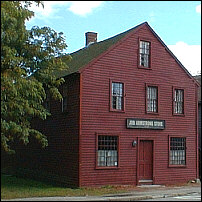|
||||||||||||||||||||
|
July 10, 2003 Reuben Mason House Will Be Saved
That will allow the society to begin seeking grants and funding to restore the ancient structure, once used as a field hospital during the Dorr War. "It's going to be a very big undertaking," says Rose LaVoie, who spearheaded the move to save the building, located on the side of Putnam Pike (Route 44) on Acotes Hill, directly in front of Acotes Cemetery. Mrs. LaVoie pegged the total cost of saving the structure near the $400,000 mark, which would include a complete restoration of the building, plus the addition of a new well on the property. Already, she adds, they have begun filling out grant applications and seeking donations to start the project. Once funding is obtained, the outside of the building would be first on the list, followed by chimney and roof work and a general "stabilizing" of the structure before inside work would begin. The project will be overseen by the Rhode Island Historical Preservation and Heritage Commission (RIHPC) to ensure its historical accuracy and quality . "It needs to be buttoned up fairly quickly," agrees Roberta Randall, an historical architect for RIHPC. "Inside it is not in bad condition, and the structure is pretty sound." Ideally, says Mrs. LaVoie, the building, which was referred to as the "gateway to the village," would house an apartment upstairs and a museum downstairs. Hopefully, she adds, the museum could be filled with donated historical artifacts from other local residents. Mrs. LaVoie and the Glocester Heritage Society got involved in the project in an attempt to prevent the building from deteriorating further or even being torn down. If it were going to be saved, she said, now is the time to do it. Not when it is too late, as has been the case with some other structures in town which have gone the way of the wrecking ball or fire. According to Edward F. Sanderson, executive director of the RIHPC, the 18th century two story center chimney structure is not only significant for its colonial architecture, but for its historical importance, as well. Mason, who built the house before 1776, served as a surgeon in General William West's brigade during the Revolutionary War and was a prominent political figure in the town. Mr. Sanderson went on to say in a letter to the society that in 1842 the house, then occupied by Benjamin Keach, was an integral part of the final scene of the Dorr War. Approximately 700 of Dorr's supporters assembled in Chepachet and prepared to battle the Rhode Island State Militia at Acotes Hill. Those same forces commandeered the house to be used as a military hospital. Last fall RIHPC members, including Ms. Randall, inspected the building and agreed that it was salvageable. Mr. Sanderson noted that the house is in basically sound condition now, but if left un-maintained it would continue to deteriorate to a point where preservation would not be possible and a significant part of the history of Chepachet Village would be lost. "I think any building in this town which is so old and has so much historical significance is important not only to this town but to the state as well," added Mrs. LaVoie. "I think there is going to be a lot of interest in this project when the story gets out." "This is a great project," agrees Ms. Randall. "We'd really like to see this historical society succeed in saving this. There are definitely buildings worthy of historical preservation which don't get saved. It is really important that there be some evidence of the past in physical form which can speak to those times from which it came. Every building has a story to tell." 'I think any building in this town which is so old and has so much historical significance is important...' - Rose LaVoie |
||||||||
|


